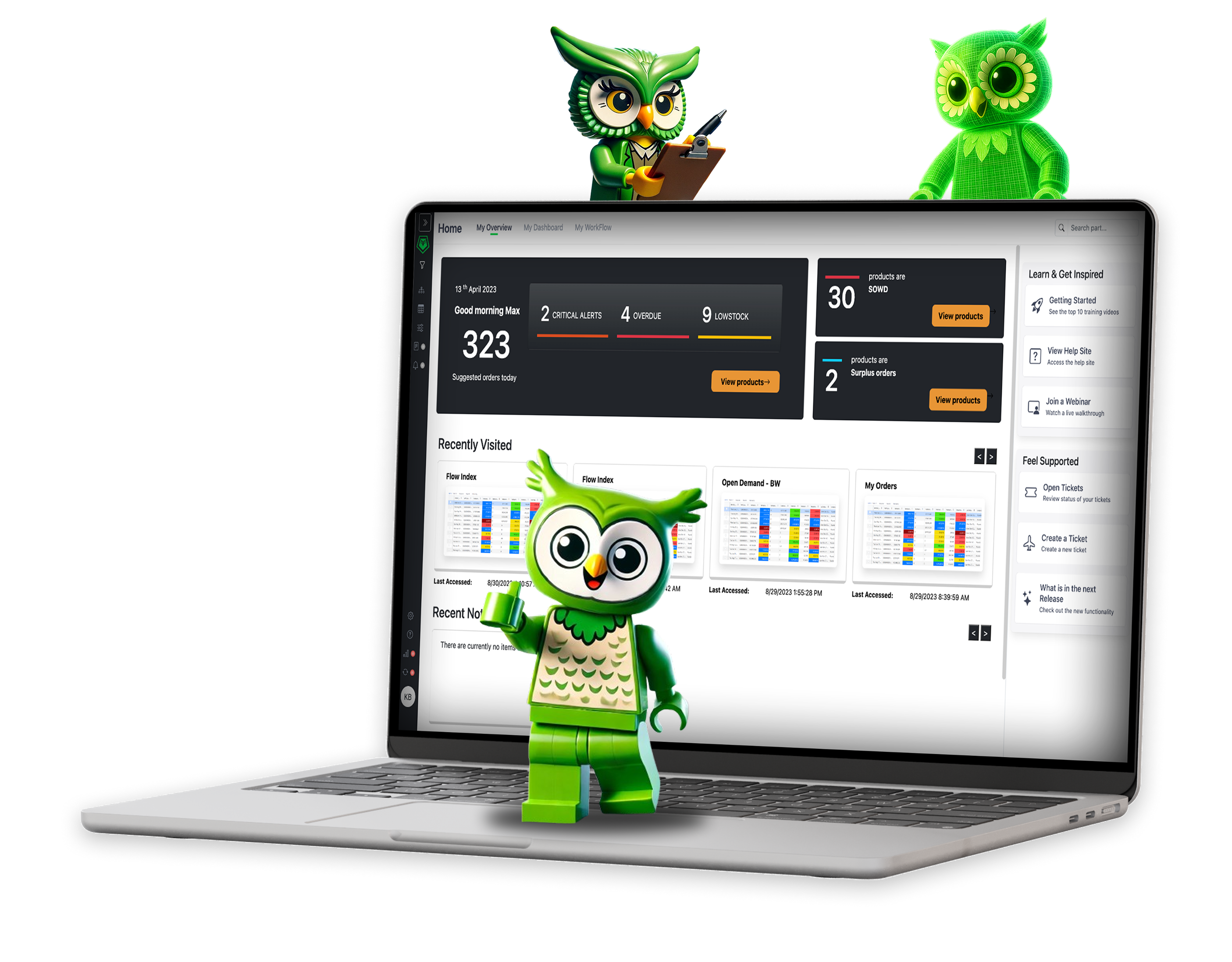
Maximiser la performance de votre entreprise en utilisant la planification de la supply chain pilotée par les flux.
Les chiffres ne mentent pas.
Les systèmes de planification classiques sont sous-performants dans le monde complexe et volatile d'aujourd'hui. Chez b2wise, notre plateforme de planification IA synchronisant le flux sur la demande réelle est conçue pour maximiser les revenus générés par vos opérations et libérer le cash des entreprises.
Les systèmes de planification classiques sont sous-performants dans le monde complexe et volatile d'aujourd'hui. Chez b2wise, notre plateforme de planification IA synchronisant le flux sur la demande réelle est conçue pour maximiser les revenus générés par vos opérations et libérer le cash des entreprises.

La méthodologie Demand Driven MRP bénéficie de l’adhésion de plus de 2500 entreprises dans 20 secteurs d’activité.
avec plus de 12 000 personnes formées, 7 livres publiés et plus de 100 études de cas






.png)






.png)






.png)
La valeur débloquée à l’aide de la plateforme b2wise

15 à 20 %
D’augmentation du taux de service

30 %
De réduction des délais de production

70 %
De gain d’efficacité des planners

20 à 50 %
De réduction de stock

12 à 18 %
D’amélioration de l’efficacité des ressources de production
$
15
Milliards
De stock gérés
10 000
+
Utilisateurs
8 000
+
Points de stockage
50
+
Pays
Votre plan livré avant même que votre café du matin ne refroidisse.
Le 4 piliers d'un projet réussi

1. Formation
Ne prenez pas le risque. Formez et certifiez vos planificateurs pour qu'ils puissent travailler efficacement.

2. Transformation
Concevez un modèle basé sur les flux. Définissez les processus. Nettoyez les données.

3. Logiciel et IA
Facile à comprendre.
Facile à utiliser.
Facile à mettre en œuvre.
Facile à utiliser.
Facile à mettre en œuvre.

4. Support
Au-delà de la mise en service, c'est là que la valeur réelle est réalisée.
Les 4 modules de la plateforme pour assurer une planification plus intelligente avec b2wise
b2wise vous fournit une solution intégrée de planification avancée pour la planification, les prévisions et l’exécution, conçue à l’aide de méthodologies basées sur les flux telles que le DDMRP, Lean Manufacturing, Theory of Constraints et Six Sigma.
L'objectif ? Fournir un modèle opérationnel stable qui maximise les revenus générés par vos activités.
Ensuite, notre solution CommWise.AI Studio vous permet de concevoir rapidement de nouvelles fonctionnalités customisées (comme le S&OP), de numériser vos processus, de créer des rapports pertinents et d’optimiser vos paramétrages.
Le résultat ? Vous gagnez en agilité, en confiance et en maîtrise de votre supply chain.
L'objectif ? Fournir un modèle opérationnel stable qui maximise les revenus générés par vos activités.
Ensuite, notre solution CommWise.AI Studio vous permet de concevoir rapidement de nouvelles fonctionnalités customisées (comme le S&OP), de numériser vos processus, de créer des rapports pertinents et d’optimiser vos paramétrages.
Le résultat ? Vous gagnez en agilité, en confiance et en maîtrise de votre supply chain.
Nous avons pu réduire nos stocks de plus de 44 %. Nous avons réduit notre obsolescence de plus de 40 %, tandis que nous avons amélioré notre niveau de service à un OTIF de 95 %. Et maintenant, notre disponibilité première s’est améliorée de 73 % à 90 %.
Ricardo Bribiesca, directeur de la supply chain LATAM -
Leader du marché de la formation certifiante
b2wise est l’affilié du DDI, leader mondial de la formation Demand Driven (DDMRP, AS&OP, DDAE)... b2wise est également un partenaire de formation certifié ASCM.
Nous pensons que vos employés sont votre plus grand atout et c'est pourquoi nous commençons tous nos programmes en leur proposant une formation qui permettra à votre organisation de réussir.

6Années leader mondial

+12 000Personnes formées

26Instructeurs

12Langues
Intégration simple et rapide avec votre ERP
Débloquez la puissance de vos données
b2wise s'intègre parfaitement à votre système ERP. La plateforme a été connectée à plus de 40 ERP et la liste ne cesse de s'allonger. Pour SAP (S4/Hana, ECC6, SAP by Design et Business One), Microsoft D365 (F&O, BC et Great Plains), NetSuite et Sage X3, nous fournissons et gérons les connecteurs.
« Au cours de mes 30 années de collaboration avec SAP, l'intégration b2wise a été de loin la meilleure et la plus rapide que j'ai jamais connue. cela a été transparent pour notre équipe. »
Responsable SAP -

Secteurs et Verticaux
b2wise a établi des partenariats avec ses clients issus d'un large éventail de secteurs industriels pour mettre en œuvre son système de planification avancée piloté par les flux.
Bien que chaque secteur d'activité ait ses spécificités, les objectifs restent les mêmes : en accélérant le flux de matières et d'information, vous améliorerez les niveaux de service, augmenterez les taux de remplissage, réduirez les stocks, améliorerez la réactivité à la demande et raccourcirez votre cycle de génération de cash.
Bien que chaque secteur d'activité ait ses spécificités, les objectifs restent les mêmes : en accélérant le flux de matières et d'information, vous améliorerez les niveaux de service, augmenterez les taux de remplissage, réduirez les stocks, améliorerez la réactivité à la demande et raccourcirez votre cycle de génération de cash.
Pourquoi b2wise?
Chez b2wise, nous existons pour vous donner un avantage concurrentiel.
En combinant méthodologie de planification efficace, une IA puissante et beaucoup d’expérience, de passion et d’énergie, nous vous aidons à transformer votre supply chain en une force qui vous démarquera sur le marché.
En combinant méthodologie de planification efficace, une IA puissante et beaucoup d’expérience, de passion et d’énergie, nous vous aidons à transformer votre supply chain en une force qui vous démarquera sur le marché.

Leader mondial
Nous sommes le leader mondial de la formation Demand Driven, employant 6 des 10 meilleurs instructeurs du monde.

Sur mesure
Nous combinons de manière unique la formation, le logiciel et le support pour garantir des résultats rapides et un succès continu.

Inspirations pour l'IA
Nous sommes de grands fans de l’IA et travaillons chaque jour avec nos clients pour fournir des innovations et améliorer la prise de décision.

Communauté
Nous construisons une communauté mondiale du Demand Driven visant à partager les meilleures pratiques.
Prêt à voir b2wise en action ?










































